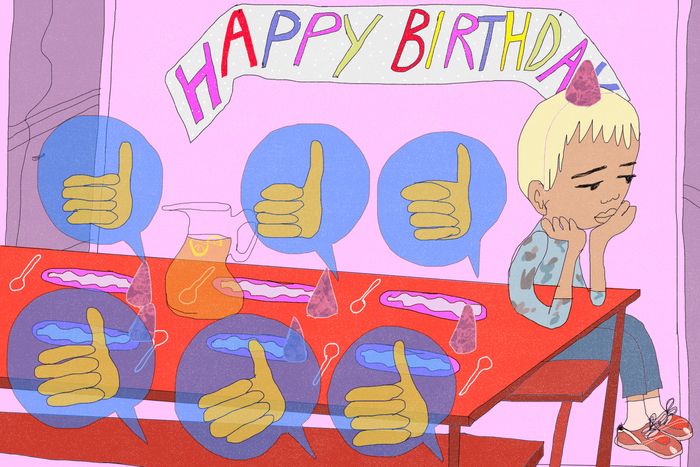
This article originally appeared in Brooding, a newsletter delivering deep thoughts on modern family life. Sign up here.
There’s a genre of viral content that has emerged over the last five or so years that I call “lonely-kid content.” These are videos and posts based on scenarios where a lonely kid is “cheered up” by someone in the kid’s life who “takes to social media” (as the misty-eyed morning show hosts invariably put it) and asks people to “show up” for the kid. The classical form of lonely-kid content is the birthday party that no one shows up to. The mom (or grandma — a female relative, anyway) bearing witness to the lonely kid creates a post about how their child is heartbroken. You won’t believe what happens next: The post goes viral and magic ensues!
Strangers might show up at the pizza place where the bummer birthday party is being held and spontaneously serenade the child! Millions of strangers might offer their birthday wishes in the comments! The Phoenix Suns’ social-media manager might seize the opportunity to create a little family-friendly buzz by inviting the lonely child to a game! And thus, the day is saved. Not only that, but syndicated morning shows across the land get another 30 seconds of content with a safe segment about “the power of social media being used for good.”
The birthday-party formula has been so widely used that some commenters are starting to assume that moms are staging these viral stunts by not inviting anyone to the party in the first place. A dark vision indeed, but I wouldn’t rule it out.
The latest lonely child to go viral is an 11-year-old from Amarillo, Texas, and his story is a little bit unique because the lonely-kid content wasn’t created by a family member, but by a neighbor using the footage from his doorbell cam — making this scenario double-cursed, in my opinion.
I’m not going to refer to any of these people by name because, frankly, the fewer search results about this debacle that are permanently linked to any of them the better. The story goes that a kid rang his neighbor’s doorbell to ask if he knew any local kids he could be friends with. “I need friends, bad,” said the kid, not realizing he was addressing a camera in addition to a human man. The kid’s sincerity prompted the neighbor to create the video post — whether he asked the kid for consent is not mentioned in any of the breathless coverage of this that I’ve read — and virality faithfully ensued.
The neighbor was subsequently compelled to start a GoFundMe for the kid, which ended up raising over $37K to be used for anything the kid wants. I can certainly understand wanting to make a generous gesture for a kid having a rough time. But dropping a huge check on him out of the blue is surreal and, extensive data shows, ineffective at making people happier.
GoFundMes, as we all know, are the product of a broken society, but there’s an extent to which we’ve accepted the useful role the campaings play for people needing necessary medical treatments or for families experiencing tragedy. But a GoFundMe to cheer up a lonely kid goes way outside the boundaries of acceptable uses for this already extremely depressing tool. The possible reasons for a kid’s loneliness are myriad, but we don’t typically assume it’s caused by a lack of resources. Is he supposed to buy himself some friends? This hardly seems like an approach to finding the kind of friends he was looking for in the first place.
I wasn’t served this post in my feed — my algorithm knows better; bless its heart. My friend sent it to me; it showed up in her feed because it was shared by Cat Power, the indie musician. My friend, a musician herself who thinks a lot about online personae and how they work, was bewildered at the decision of a fellow artist to share something so questionable. “Cat Power my dude! Are you okay?!” she DM’d me.
What is going on when we rally around these lonely kids? I don’t mean to single out Cat Power here — millions of people reacted to this video, certainly many other celebrities. Often, we share things while doing other things or while waiting in line at Costco. We often share things without thinking — which is part of the problem with categorizing this genre of virality as “heartwarming.” Most of the people who interact with this content barely give it a thought.
But these stories do have an emotional resonance that feels “universal.” They elicit a sentimental indignation in us — a defiant “awwwwwww!” See? We say to ourselves. There really is good in the world. When we share these stories, we think of them as an act of resistance against the hopelessness and negativity that many of us see as endemic in social media. We see ourselves as spreaders of sunshine — even do-gooders. What this world needs is more positivity, amirite? So says the caption that accompanies a post like this.
Positivity, no matter how many people share a post, is not going to help this kid meet new friends. Making friends is hard, but certain contexts make it easier, namely free public places where peers gather. What a lonely kid needs is a local library with extended opening hours where he can join a group of kids who play Minecraft together for three hours every day on public computers.
He needs a local pool where he can go every afternoon, where he knows the lifeguards (not enough money for those lately, though), where he can just kind of reside in public with a loose group of friends and acquaintances. Get a little sunburnt, share a bag of Cheetos, watch some stupid TikToks on another dude’s phone in the shade. He needs a resourced school with counselors who can help him deal with bullying, and he needs parents who have the time to engage with him and talk to him about how he’s feeling. What he does not need are thousands of inane comments from total strangers about how he’s “awesome” and $37k for amusement park tickets.
When we start to think of social change as “pushing back against negativity” online by sharing these stories, we really are doomed, guys. It would have been interesting if the neighbor who created this post had instead dedicated the GoFundMe to a local community center for more affordable day camp or the local library for more summer programming. But that would not have had the ingredients for a heartwarming viral post. An appeal for public funding is not going to excite the algorithm.
Lonely-kid content is adjacent to clicktivism, but it’s worse. Rather than inciting people to rally around a set of ideas, it all revolves around one individual person. Unlike most clicktivism, which is usually ineffective but harmless, lonely-kid content risks actually causing harm.
When we take part in this sharing of “positivity” in the form of lonely-kid content, we’re participating in what the late, great scholar Lauren Berlant called an “intimate public” — a place where our shared feelings constitute an aesthetic, a framework of conventional ways of behaving, which creates for its participants a feeling of belonging to something larger than themselves. We sense a collective feeling, and it warms us.
The online intimate public that coalesces around these posts feels itself to be aligned with some ethical framework — a realm of “good people.” This is a total delusion. Berlant writes that the simple experience of sharing a feeling of emotional continuity with a vaguely defined group of strangers is what holds intimate publics together. She was writing about consumers of “women’s media” throughout the 20th century, but it holds just as true for “brighten up your day” content on social media. We’re here for the warm fuzzy feelings that reflect back on ourselves, however threadbare they might be.
Point being: By interacting with this content, we’re not helping a lonely kid make friends. We are not actually performing an act of care for a stranger. That’s not the point of the exercise. We’re basking in the glow of our intimate public for a hot second and then we’re out. The fallout is a kid who has to deal with the emotional aftershocks of having gone viral, which, as we’ve seen time and again, are not easy to cope with.
The doorbell-cam kid’s viral odyssey wasn’t all depressing. According to a local news affiliate, a party was organized for him at a local park — I wish they hadn’t named the party after him, something about that irks me — but it seems like a small community mobilization did occur with possible reverberations beyond the day itself, although I know better than to be too optimistic. Picnics are nice. But it’s the viral sheen of the kid that compelled people to show up in the first place, and that should strike everyone as very odd.
Making friends is a process that does not lend itself to visual documentation. It’s an intimate negotiation, a lot of which happens in our own heads as we decide how we feel about another person and what we want to share with them. There is an alchemical dimension to making a new friend. “What will happen when I say this? Or this?” It is a slow process for most of us; you could never cut it into a short video. There’s no formula. I hope this latest kid has made friends, and I hope they stick around after the afterglow of public exposure has faded.
More From This Newsletter
- Is Annoyance the Most Romantic Emotion?
- Trad or Not, We’re All Nostalgic for a Fake Past
- Should Kids Really Learn About Getting Rich?


